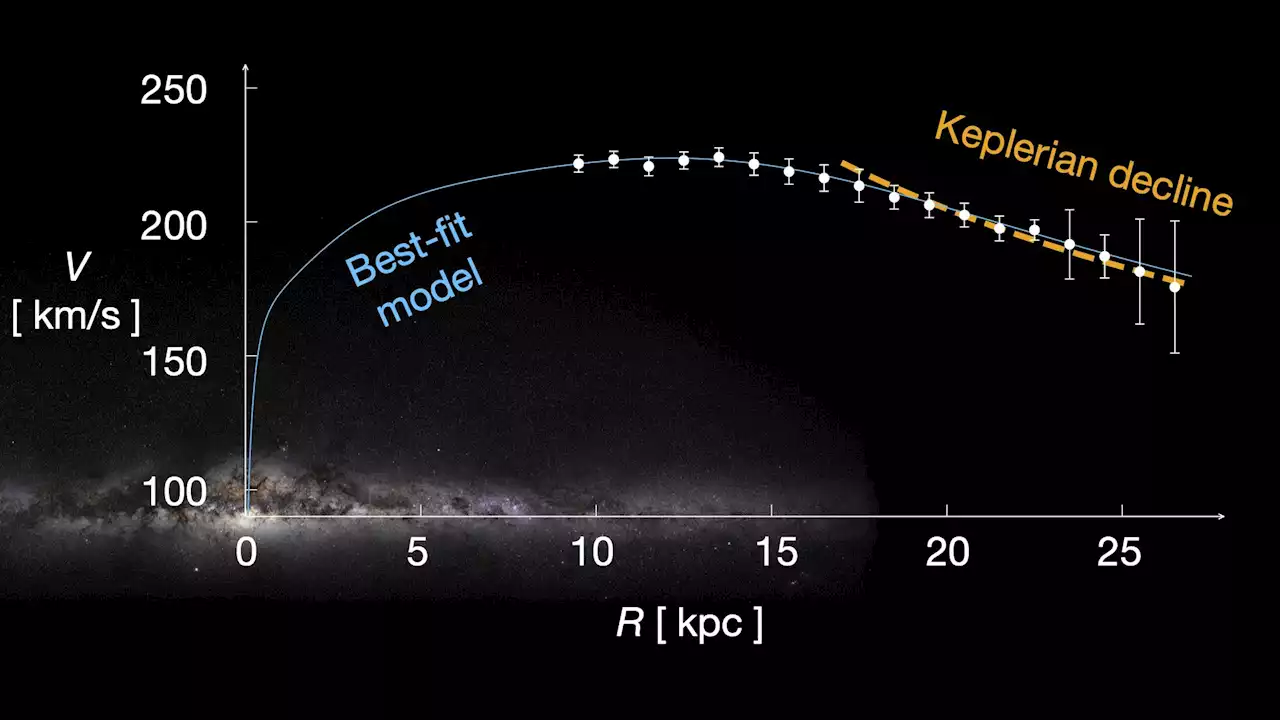How massive is the Milky Way? According to a new study using data from ESA's Gaia spacecraft, less than we thought. A new estimate puts the Milky Way's mass at 200 billion times the mass of the Sun, which is 4-5 times less than previous estimates that pegged it closer to a trillion solar masses. Using detailed information about millions of stars, astronomers were able to build an extremely accurate rotation curve for the Milky Way and use that to estimate its mass. They found that the rotation of the Milky Way isn't typical for large spiral galaxies, decreasing its estimated mass.
How massive is the Milky Way? It’s an easy question to ask, but a difficult one to answer. Imagine a single cell in your body trying to determine your total mass, and you get an idea of how difficult it can be. Despite the challenges, a new study has calculated an accurate mass of our galaxy, and it’s smaller than we thought.. Measure the speed of stars in a galaxy versus their distance from the galactic center.
But since we are in the Milky Way itself, we don’t have a great view of stars throughout the galaxy. Toward the center of the galaxy, there is so much gas and dust we. So instead we measure the rotation curve using neutral hydrogen, which emits faint light with a wavelength of about 21 centimeters. This isn’t as accurate as stellar measurements, but it has given us a rough idea of our galaxy’s mass.
The distribution of stars seen by the Gaia surveys. Credit: Data: ESA/Gaia/DPAC, A. Khalatyan & StarHorse team; Galaxy map: NASA/JPL-Caltech/R. Hurt This new study is based on the third data release of the Gaia spacecraft. It contains the positions of more than 1.8 billion stars and the motions of more than 1.5 billion stars. While this is only a fraction of the estimated 100-400 billion stars in our galaxy, it is a large enough number to calculate an accurate rotation curve. Which is exactly what the team did. Their resulting rotation curve is so precise, that the team could identify what’s known as the Keplerian decline.
The Keplerian decline allows the team to place a clear upper limit on the mass of the Milky Way. What they found was surprising. The best fit to their data placed the mass at about 200 billion solar masses, which is a fifth of previous estimates. The absolute upper mass limit for the Milky Way is 540 billion, meaning that the Milky Way is at least half as massive as we thought.
Canada Latest News, Canada Headlines
Similar News:You can also read news stories similar to this one that we have collected from other news sources.
![]() Photographer Captures Meteors, Milky Way Galaxy, and Bioluminescence in One PhotoComposite are cool, but this is cooler.
Photographer Captures Meteors, Milky Way Galaxy, and Bioluminescence in One PhotoComposite are cool, but this is cooler.
Read more »
 Mass. GOP settles campaign finance allegations with the stateThe state's Republican Party will pay $15,000 to the state as part of the agreement.
Mass. GOP settles campaign finance allegations with the stateThe state's Republican Party will pay $15,000 to the state as part of the agreement.
Read more »
 This Week in Fact Checking: Biden’s Mass Shooting Claim, O...News coverage often includes several forms of bias, and sometimes even flat-out
This Week in Fact Checking: Biden’s Mass Shooting Claim, O...News coverage often includes several forms of bias, and sometimes even flat-out
Read more »
 Commuter Alert: Get latest service updates on subways, trains and all mass transit hereHeavy rain is wreaking havoc on all transit in New York City and throughout the tri-state, with flooding already causing major suspensions and delays — and there’s still hours to go with this storm. Several subway lines had service interrupted due to flooded tracks and video showed roads throughout the five boroughs and surrounding areas nearly, if not completely, impassable….
Commuter Alert: Get latest service updates on subways, trains and all mass transit hereHeavy rain is wreaking havoc on all transit in New York City and throughout the tri-state, with flooding already causing major suspensions and delays — and there’s still hours to go with this storm. Several subway lines had service interrupted due to flooded tracks and video showed roads throughout the five boroughs and surrounding areas nearly, if not completely, impassable….
Read more »
